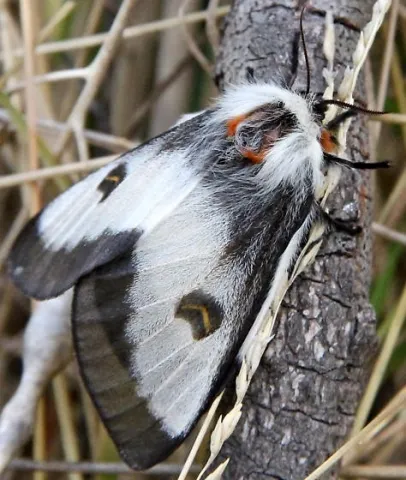
Nevada Buck Moth
By Norman Smith UCCE Master Gardener
Let' s veer away from the creepy (black widows and tarantulas) to something much less intimidating. The Nevada Buck Moth is another unusual California insect. First, it is a day flying moth. With the wing pattern looking somewhat like that of a butterfly, it is typical for day flying moths to often look like butterflies. This color pattern though, is most likely a warning pattern for potential predators. Obvious black and white bands and with a splash of red scaling on the abdomen indicates that this moth is probably distasteful. I have seen large populations of this moth on the west side of the central valley but never seen it being eaten by a bird.
Secondly, this is a fall active adult moth. They fly from late September to early December, with the peak flight around October 30th, taking advantage of the warm fall days in California. Female moths lay their eggs around the branches of willows in wash areas of California. Eggs hatch in mid-March when spring growth of willows occurs. This is perfect timing for the moth. Mature larvae drop to the ground to pupate in leaf litter beneath the willows in mid- June. By this time most standing water in the wash has evaporated. Then, the moth hatches in fall before winter rains occur. Pupae in the leaf litter when the wash becomes flooded would likely drown, but since the moth has already hatched that doesn't happen. Eggs on the willows are well above any water that occurs during the wet season. A well-adapted moth for this type of habitat.
Caterpillars are full of spines that are urticating - meaning they sting if bumped against or grabbed by a human or animal. Though not deadly, the pain is something you don't forget and reminds you to use caution when handling the caterpillars in the future. Larvae appear to prefer the hot dry weather of the central valley, and don't do well in areas with cool, cloudy days. This is probably one reason why despite having what would seem to be favorable habitat for this moth along the central coast, it does not occur here.

